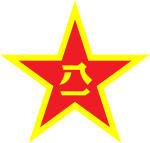
Back Lugmag van die Volksbevrydingsleër Afrikaans القوات الجوية لجيش التحرير الشعبي الصيني Arabic Çin Xalq Azadlıq Ordusu Hərbi Hava Qüvvələri Azerbaijani Força Aèria de l'Exèrcit Popular d'Alliberament Catalan Letectvo Čínské lidové osvobozenecké armády Czech Luftstreitkräfte der Volksrepublik China German Popola Liberiga Aerarmeo Esperanto Fuerza Aérea del Ejército Popular de Liberación Spanish نیروی هوایی ارتش آزادیبخش خلق Persian Kansan vapautusarmeijan ilmavoimat Finnish
| People's Liberation Army |
|---|
 |
| Executive departments |
| Staff |
| Services |
| Arms |
| Domestic troops |
| Special operations forces |
| Military districts |
| History of the Chinese military |
| Military ranks of China |
The People's Liberation Army Air Force,[a] also referred to as the Chinese Air Force (中国空军) or the People's Air Force (人民空军), is an aerial service branch of the People's Liberation Army. The Air Force is composed of five sub-branches: aviation, ground-based air defense, radar, Airborne Corps, and other support elements.[4]
The PLAAF traces its origins to the establishment of a small aviation unit by the Chinese Communist Party (CCP) in 1924, during the early years of the Republic of China. This initial group comprised nine cadets who trained under the Guangzhou Revolutionary Government Aviation Bureau, with further advanced training in the Soviet Union. Despite initial resource constraints, including a lack of aircraft and airfields, the CCP's Central Military Commission (CMC) established foundational aviation schools and, by the end of World War II, had begun significant organizational developments.
The formal establishment of the PLAAF occurred in November 1949, following the CCP's victory in the Chinese Civil War. Early on, the PLAAF operated a mix of captured Kuomintang (KMT) and Soviet aircraft and began organizing its structure around several aviation divisions. The PLAAF first faced combat in the Korean War against the United States using primarily the Mikoyan-Gurevich MiG-15 fighter aircraft provided by the Soviet Union, which also assisted with the expansion of the Chinese aerospace industry. Post-Korean War, the PLAAF focused on enhancing air defense capabilities, a strategy influenced by political decisions to limit offensive operations. The 1960s brought considerable challenges due to the Sino-Soviet split, which strained resources and technical support. This period also saw the detrimental impacts of the Cultural Revolution on the PLAAF's development and readiness. In the following decades, especially the 1980s, the PLAAF underwent significant reforms which included force reduction and reorganization aimed at modernizing its capabilities in line with advancing air power technology. These efforts were somewhat hampered by the aftermath of the 1989 Tiananmen Square protests and massacre, which resulted in Western sanctions but eventually led to increased military collaboration with Russia in the 1990s.
Entering the 21st century, the PLAAF made substantial progress in transitioning to more modern airpower with the acquisition and development of advanced aircraft like the Sukhoi Su-27 and domestic models such as the J-10 and J-20. The strategic orientation of the PLAAF continued to evolve with a focus on expanding its operational capabilities, including the development of long-range bombers and enhancing joint operational capacity with other branches of the Chinese military.
- ^ "空军司令部的组建". January 23, 2015. Archived from the original on July 11, 2016. Retrieved September 16, 2018.
中国空军网_蓝天回眸_空军简史
- ^ International Institute for Strategic Studies 2020, p. 264.
- ^ International Institute for Strategic Studies 2020, p. 265.
- ^ Rupprecht, Andreas (29 October 2018). Modern Chinese Warplanes:Chinese Air Force - Aircraft and Units. Harpia Publishing. p. 139. ISBN 978-09973092-6-3.
Cite error: There are <ref group=lower-alpha> tags or {{efn}} templates on this page, but the references will not show without a {{reflist|group=lower-alpha}} template or {{notelist}} template (see the help page).




